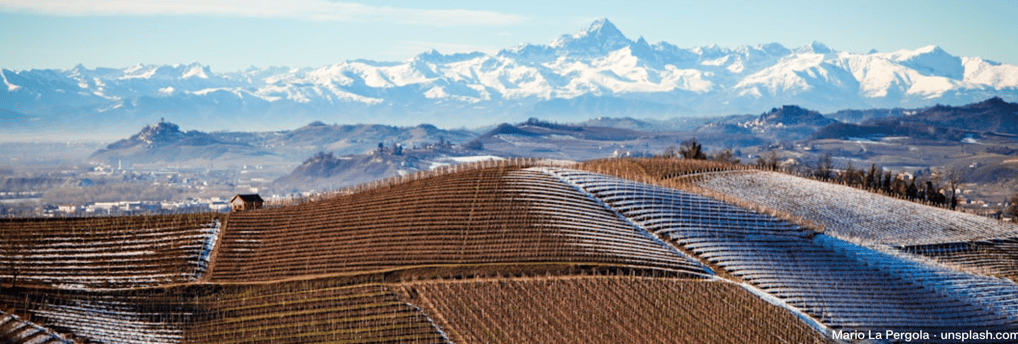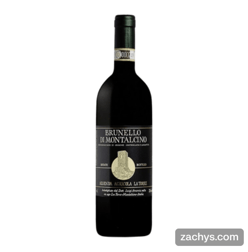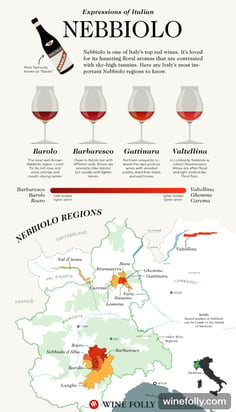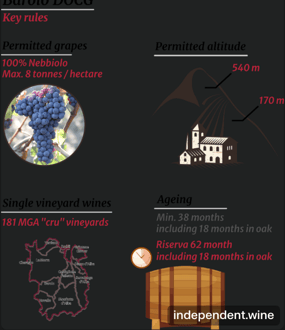Barolo, Barbaresco, Brunello
Dive into the world of Italy’s most iconic wines—Barolo, Barbaresco, and Brunello. This post explores the unique flavors, aromas, and personalities of these legendary reds, perfect for wine lovers looking to elevate their tasting experience. Discover what makes each one special and how to enjoy them at their best!
WINE REGIONS
Otavio Marques
1/4/20255 min read


The "Three B's" of Italian wine refer to Barolo, Barbaresco, and Brunello di Montalcino, renowned as some of the world's greatest red wines. These prestigious appellations, often called the "Killer B's," are celebrated for their exceptional quality, aging potential, and distinct characteristics that reflect their unique terroirs in Piedmont and Tuscany.
Sangiovese's Role in Brunello
Brunello di Montalcino, the third of Italy's "Killer B's," is crafted exclusively from Sangiovese grapes, specifically the Sangiovese Grosso clone known locally as "Brunello" or "Prugnolo Gentile".
This prestigious wine hails from the picturesque hilltop town of Montalcino in Tuscany, where the unique terroir and climate contribute to its distinctive character. The Sangiovese Grosso used in Brunello di Montalcino thrives in the region's rocky, mineral-rich soil and intense sun exposure.
These challenging growing conditions result in grapes with thick, resilient skins that produce wines of exceptional structure and longevity. The combination of terroir and grape variety yields wines with complex flavors and aromas, typically featuring notes of cherry, blackberry, violet, leather, and earthy undertones.
Brunello di Montalcino's production is strictly regulated under Italy's highest wine classification, Denominazione di Origine Controllata e Garantita (DOCG).
Key requirements include:
100% Sangiovese grapes
Minimum alcohol content of 12.5%
Extensive aging process: at least 5 years before release, including a minimum of 2 years in oak barrels and 4 months in bottle
This lengthy maturation period allows Brunello to develop its characteristic depth and complexity. The wine's high tannin content and acidity contribute to its excellent aging potential, with many examples improving for 20-30 years or more.
Brunello di Montalcino's production is relatively limited compared to other Italian wines, with approximately 330,000 cases produced annually.
This scarcity, combined with its exceptional quality and aging requirements, contributes to its status as one of Italy's most prestigious and sought-after wines.The use of Sangiovese in Brunello di Montalcino showcases the grape's versatility and potential for producing world-class wines. While Sangiovese is widely used throughout Tuscany, including in Chianti, the unique expression found in Brunello demonstrates how terroir and winemaking practices can elevate a familiar grape variety to extraordinary heights.
Nebbiolo's Influence on Barbaresco
Barbaresco, like its more famous cousin Barolo, is crafted exclusively from the Nebbiolo grape, a variety that thrives in the Piedmont region of northwestern Italy. The Nebbiolo grape imparts distinctive characteristics to Barbaresco wines, creating a unique expression of terroir that sets it apart from other Italian reds.
Grown in the Langhe area of Piedmont, Barbaresco benefits from a slightly warmer microclimate than Barolo, largely due to its proximity to the Tanaro River. This geographical advantage allows the Nebbiolo grapes to ripen earlier, resulting in wines that are generally more approachable in their youth compared to Barolo.
The Nebbiolo grape's influence on Barbaresco is evident in the wine's aromatic profile and flavor composition. Barbaresco wines typically exhibit floral notes of rose petals and violets, accompanied by red fruit aromas such as cherry. As the wine ages, it develops more complex flavors, including licorice, leather, and rich chocolate notes.
One of Nebbiolo's defining characteristics is its high tannin content, which is prominently displayed in young Barbaresco wines. However, these tannins tend to soften more quickly than in Barolo, contributing to Barbaresco's reputation for earlier drinkability. Despite this, Barbaresco still possesses excellent aging potential, with many examples improving for decades.
The DOCG regulations for Barbaresco reflect the unique qualities of Nebbiolo grown in this area. The wine must be made from 100% Nebbiolo grapes and aged for a minimum of two years before release, including at least nine months in oak barrels. For Barbaresco Riserva, an additional two years of aging is required.
Barbaresco's production is concentrated in three main communities: Barbaresco, Neive, and Treiso. Each subregion imparts subtle differences to the wine, with many considering the wines of Neive to be the finest examples of Barbaresco.
The influence of Nebbiolo on Barbaresco extends beyond its flavor profile. The grape's naturally high acidity contributes to the wine's structure and longevity, while its thin skin results in wines with a characteristic pale garnet color that lightens with age.
In essence, Nebbiolo's influence on Barbaresco creates a wine that is often described as more perfumed and softer than Barolo, yet still possessing the complexity and aging potential that has made Nebbiolo-based wines from Piedmont some of the most sought-after in the world.
Barolo's Aging Requirements
Barolo, often referred to as the "King of Wines," is renowned for its strict aging requirements that contribute to its complexity and longevity. These rigorous standards set Barolo apart from other Italian wines and play a crucial role in developing its distinctive character. According to Italian wine law, Barolo must undergo a minimum aging period of 38 months after harvest before release, with at least 18 months spent in oak or chestnut barrels.
This extended maturation process allows the wine to soften its robust tannins and develop its complex flavor profile. The oak aging imparts subtle woody notes and contributes to the wine's structure, while bottle aging helps integrate the various components of the wine. For wines designated as Barolo Riserva, the aging requirements are even more stringent. These premium expressions must age for a minimum of 62 months (over 5 years), including at least 18 months in oak.
This extended aging period allows Riserva wines to develop additional layers of complexity and depth, resulting in wines that are often considered the pinnacle of Barolo production. It's worth noting that while these are the minimum requirements, many producers choose to age their Barolos for even longer periods. It's not uncommon to find Barolo wines that have been aged for 10, 20, or even 30 years.
This extended aging potential is a testament to the wine's structure and the quality of the Nebbiolo grapes from which it is made. The aging process significantly influences Barolo's flavor profile. Young Barolos are known for their powerful tannins and high acidity, which can make them challenging to drink upon release. However, as the wine ages, it develops a more nuanced and complex character. Mature Barolos often display a bouquet of roses, tar, truffles, and dried fruits, with flavors evolving to include notes of leather, tobacco, and earthy undertones.
Barolo's aging requirements are more demanding compared to its close relative, Barbaresco. While Barbaresco requires a minimum of 2 years of aging (with 9 months in oak), Barolo's 38-month minimum (with 18 months in oak) results in wines that are generally more tannic and structured in their youth.
This difference in aging requirements contributes to the distinct personalities of these two prestigious Nebbiolo-based wines. The strict aging regulations for Barolo not only ensure a certain level of quality but also contribute to the wine's scarcity and prestige. These factors, combined with the wine's exceptional aging potential, have solidified Barolo's reputation as one of Italy's most celebrated and sought-after wines.






